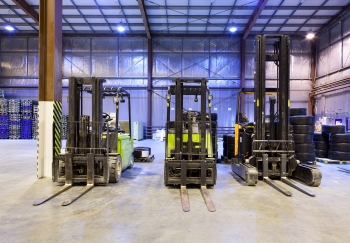Classification Of Powered Industrial Trucks And OSHA Forklift Regulations
OSHA defines a powered industrial truck (PIT) as any mobile, power-propelled truck used to carry, push, pull, lift, stack, or tier materials, whether ridden by the operator or controlled by a walking operator. Companies who use PITs are required to provide training consisting of formal instruction, practical training and evaluation of the operator’s performance in the workplace for the specific type of PIT that operator will be using. This training and evaluation must cover mandatory topics specified in the OSHA standard and be certified by the employer. The operator’s certification must include name, dates of training and evaluation, and the name(s) of the person(s) conducting the training and evaluation. The employer is also responsible for verifying required refresher training and evaluation.
 Classification of Powered Industrial Trucks
Classification of Powered Industrial Trucks
- Class I – Electric motor rider trucks included in Class I are counter-balanced, and the operator rides on the truck, either standing or seated. Class I vehicles include three-wheel electric sit-down trucks; and high- and low-platform sit-down rider type trucks with cushion tires or pneumatic tires.
- Class II – Class II consists of electric motor narrow aisle trucks such as high-lift straddle, order pickers, reach-type outriggers, side-loaders, turret trucks, swing mast and convertible turret stock pickers, and rider low-lift pallet and platform trucks.
- Class III – Electric motor hand-trucks are included in Class III: Low-lift platforms, walkie-pallets, or rider pallets; reach-type outriggers; high-lift straddle; and high-lift counter-balanced trucks.
- Class IV – Internal combustion engine trucks with cushion tires are included in Class IV. The vehicle is counter-balanced and has forks and solid tires.
- Class V – Class V trucks differ from Class IV trucks in tires: Class V vehicles have pneumatic (air-filled) tires.
- Class VI – Class VI trucks are tractors with either electric of internal combustion engines.
- Class VII – Rough terrain forklift trucks comprise Class VII, including straight-mast forklifts and extended-reach forklifts.
Refresher Training and Evaluation
Refresher training and evaluation is required to ensure that the operator has the knowledge and skills needed to operate the PIT safely when:
- The operator has been observed to operate the vehicle in an unsafe manner;
- The operator has been involved in an accident or near-miss incident;
- The operator has received an evaluation that reveals that the operator is not operating the truck safely;
- The operator is assigned to drive a different type of truck; or
- A condition in the workplace changes in a manner that could affect safe operation of the truck.
Additionally, evaluation of each PIT operator’s performance is required once every three years, minimum. Optimum Safety Management recommends re-training and evaluation on an annual basis.
Optimum Safety Management Can Help Your Company Comply with OSHA Forklift Regulations
Optimum Safety Management provides comprehensive OSHA Services, including training, refresher training, and certification to meet OSHA forklift regulations and vehicle safety standards, and any other OSHA compliance demands your company is required to meet. Contact us for an overall safety management assessment, or to set up the specific training and certification you need for safe and compliant operations.








